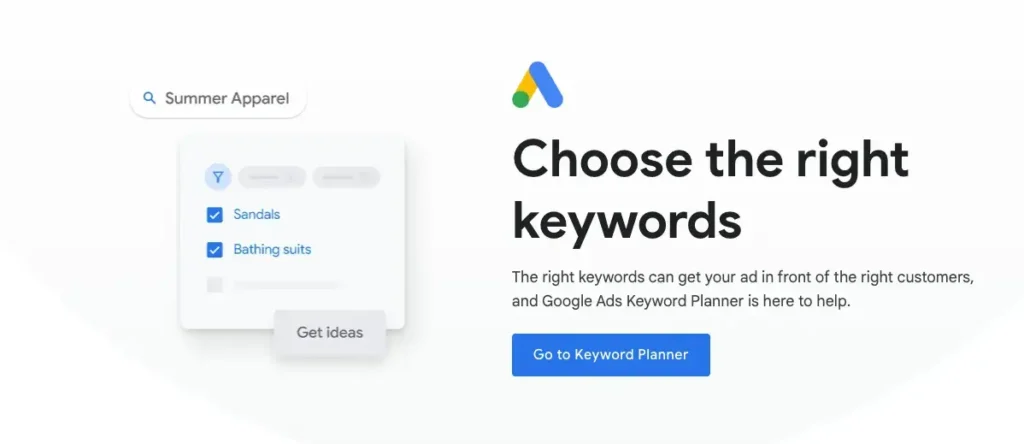Choosing the right keywords is a foundational part of SEO (Search Engine Optimization). Whether you’re managing a blog, an e-commerce site, or a professional portfolio, effective keyword research can improve your visibility, attract more visitors, and ultimately convert these visitors into loyal customers or readers. Here’s a step-by-step guide to help you choose the right keywords that are relevant, effective, and tailored to your audience.
1. Understand Your Audience
Before jumping into right keywords research, take time to understand your target audience. Knowing who they are, what they’re interested in, and how they search for information online is crucial.
- Identify Audience Demographics: What age group does your audience belong to? Are they primarily male or female? What are their interests and pain points? This information can help guide your keyword research to better match what your audience is searching for.

- Analyze Search Intent: Search intent refers to the reason behind a user’s search. Are they looking to buy a product, find information, or compare options? Understanding this intent will help you choose right keywords that align with your audience’s needs.
2. Brainstorm Broad Topics Relevant to Your Business
Begin by brainstorming a list of broad topics relevant to your industry or niche. Think about the main categories your website or business addresses. For example:
- If you own an online pet store, broad topics might include “pet food,” “pet toys,” and “pet grooming.”
- If you’re in digital marketing, broad topics might be “SEO tips,” “content marketing,” and “social media strategies.”
These broad topics serve as a foundation for finding more specific and right keywords.
3. Generate Keyword Ideas
Now that you have a list of broad topics, it’s time to brainstorm specific keyword ideas.
- Google Auto-Suggest: Type one of your broad topics into Google’s search bar. Google’s auto-suggest feature will display related keywords that people commonly search for. This can give you an idea of popular phrases related to your topic.
- “People Also Ask” Box: This feature on Google shows common questions related to your search. These questions can be valuable keyword ideas and can also inspire content that answers specific questions your audience may have.
- Competitor Analysis: Look at competitors who rank well in your industry. Use tools like Ahrefs, SEMrush, or even Google Search to find out what right keywords they rank for. This can reveal keywords you may not have thought of and help you identify potential gaps in their content that you could fill.
4. Use Keyword Research Tools
Once you have a list of potential right keywords, use a keyword research tool to analyze them. Many tools provide data on search volume, keyword difficulty, and competition. Here are some popular tools:
- Google Keyword Planner: This free tool by Google is widely used for its accuracy and insights, providing keyword suggestions, search volume, and CPC (cost per click) data.
- Ahrefs & SEMrush: These are powerful paid tools that give you an in-depth analysis of keywords, including competitor insights, keyword difficulty, and ranking potential.
- AnswerThePublic: This tool generates a list of questions, comparisons, and related keywords based on a single keyword. It’s particularly useful for finding long-tail keywords and creating content around specific queries.
Read this also: Best way to get high rankings is by doing off page SEO
5. Analyze Keyword Metrics
Keyword metrics will help you understand which right keywords are worth targeting. Focus on three key metrics:
- Search Volume: This is the average number of times a keyword is searched per month. High search volume generally means more potential traffic, but it can also indicate high competition.
- Keyword Difficulty: This metric estimates how difficult it would be to rank for a keyword. Many tools use a score from 0 to 100; higher scores indicate more competition. Targeting keywords with moderate difficulty can yield better results, especially if your website is relatively new.
- Cost Per Click (CPC): CPC shows the average cost that advertisers pay for each click on an ad for that keyword. A higher CPC indicates that the keyword has strong commercial intent, meaning that it’s popular among advertisers.
6. Focus on Long-Tail Keywords
Long-tail keywords are longer and more specific phrases, usually with lower search volume and competition. Despite this, they’re highly valuable for SEO because they often attract users with clearer intent.
For example:
- Instead of “running shoes,” try “best running shoes for marathon training” or “affordable running shoes for beginners.”
Long-tail keywords generally have lower competition, which increases your chances of ranking well in search results. They also attract visitors who are closer to taking action, such as making a purchase or signing up.
7. Prioritize Low-Competition Keywords for New Websites
If your website is new or doesn’t have a high domain authority, prioritize low-competition keywords. These keywords may not bring in large amounts of traffic right away, but they can help you build authority in your niche.
Start with low-difficulty keywords and gradually move up as your site gains authority and credibility. Over time, this can improve your overall site ranking, making it easier to target higher-competition keywords down the line.
8. Group Keywords by Search Intent
Organize your right keywords based on search intent. There are four types of search intent:
- Informational: Keywords where users are looking for information, such as “how to train a puppy.”
- Navigational: Keywords where users are looking for a specific website or brand, like “Facebook login.”
- Transactional: Keywords with purchase intent, such as “buy running shoes online.”
- Commercial Investigation: Keywords where users are researching before a purchase, like “best budget smartphones 2024.”
Grouping right keywords by intent helps you create content that directly serves your audience’s needs at different stages of the customer journey. It also makes it easier to plan and create targeted content.
9. Test and Refine Your Right Keywords Strategy
SEO is an ongoing process, so monitor the performance of your keywords and refine your strategy as needed. Use tools like Google Analytics, Google Search Console, and your keyword research tool to track which keywords are driving traffic and conversions.
- Monitor Keyword Rankings: Check your rankings for targeted keywords to see if they improve over time. This will help you identify which keywords are performing well and which need more work.
- Optimize Underperforming Pages: If certain pages aren’t ranking as expected, optimize them with additional or alternative keywords. Experiment with variations and refine your on-page SEO to boost their visibility.
- Experiment with Content Updates: For content that’s already ranking, periodic updates can maintain or improve its ranking position. Add new information, update facts, and ensure that keywords are relevant to current search trends.
Conclusion
Right Keywords research is a dynamic process that requires attention to detail and a thorough understanding of your audience. By following these steps—understanding your audience, using keyword research tools, analyzing keyword metrics, focusing on long-tail keywords, and continuously monitoring your right keywords performance—you can create a well-rounded keyword strategy that boosts your SEO efforts and attracts high-quality traffic to your site.

